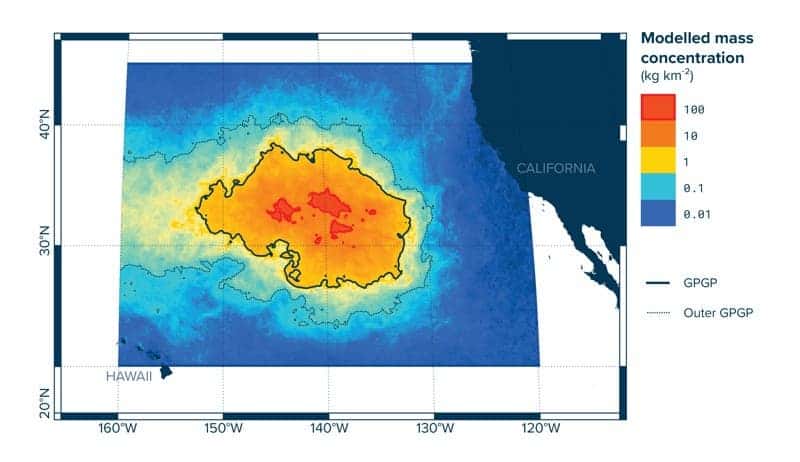The Great Pacific Garbage Patch is a lot bigger than we’ve estimated — and more dangerous in composition.

Image credits The Ocean Cleanup Foundation.
Out on the waves of the Pacific Ocean lies one of man’s greatest accomplishments. I use the last term in the loosest way possible since, by ‘great’, I mean sheer size; the aptly named Great Pacific Garbage Patch now measures a stunning 620,000 square miles (roughly 1,605,800 square km) — some 16 times larger than previously estimated.
Resting between California and Hawaii, in an area known as the Pacific gyre, the Patch has been steadily growing in current-borne plastics; and it has grown fat indeed — it now contains some 87,000 tons of plastic, a new study reports. The authors note that with the massive deluge of plastic pollution we’re generating, this Patch is growing right as we speak, and will likely keep doing so. Data gathered between 1970 and 2015 shows the plastic levels in the garbage patch are increasing at a faster rate than in surrounding waters.
Patches of Plastics
As far as huge spans of thrash are concerned, the Patch is very cosmopolitan — microplastics stew alongside larger bits of plastics, all entangled in fishing nets and gear. But, worryingly, the largest chunk of all this ‘ew’, some 46%, is made up of fishing nets, the authors report. Other types of commercial fishing gear, such as eel traps, ropes, or oyster spacers account for a majority of the rest of the trash.
The findings are part of a three-year mapping effort involving Ocean Cleanup, an international team of scientists, six universities and an aerial sensor company. They used two aircraft surveys and 30 vessels to cross the debris field and get an accurate idea of its size and composition.
“I knew there would be a lot of fishing gear, but 46 percent was unexpectedly high,” said Laurent Lebreton, member of the Ocean Cleanup Foundation. “Initially, we thought fishing gear would be more in the 20 percent range. That is the accepted number [for marine debris] globally – 20 percent from fishing sources and 80 percent from land.”
Having a lot of fishing equipment lying about in the middle of the ocean is quite a poor development; all this refuse can entangle turtles, seals, and whales; plastic items kill or injure some 100,000 marine animals each year, National Geographic reports.
Despite the gloomy outlook, the team says there are still many unknowns in regard to this garbage patch: how polluted are deeper waters? How much plastic has sunk to the sea floor? More research will have to answer these questions.
The paper “Evidence that the Great Pacific Garbage Patch is rapidly accumulating plastic” has been published in the journal Scientific Reports.


